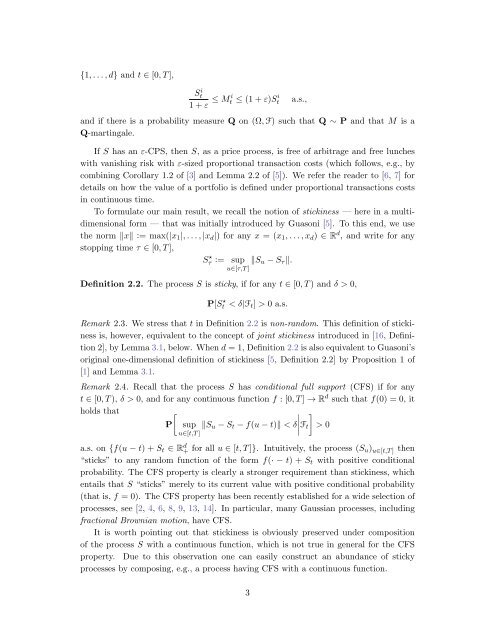Sticky continuous processes have consistent price systems
Sticky continuous processes have consistent price systems
Sticky continuous processes have consistent price systems
You also want an ePaper? Increase the reach of your titles
YUMPU automatically turns print PDFs into web optimized ePapers that Google loves.
{1, . . . , d} and t ∈ [0, T ],<br />
S i t<br />
1 + ε ≤ M i t ≤ (1 + ε)S i t a.s.,<br />
and if there is a probability measure Q on (Ω, F) such that Q ∼ P and that M is a<br />
Q-martingale.<br />
If S has an ε-CPS, then S, as a <strong>price</strong> process, is free of arbitrage and free lunches<br />
with vanishing risk with ε-sized proportional transaction costs (which follows, e.g., by<br />
combining Corollary 1.2 of [3] and Lemma 2.2 of [5]). We refer the reader to [6, 7] for<br />
details on how the value of a portfolio is defined under proportional transactions costs<br />
in <strong>continuous</strong> time.<br />
To formulate our main result, we recall the notion of stickiness — here in a multidimensional<br />
form — that was initially introduced by Guasoni [5]. To this end, we use<br />
the norm ‖x‖ := max(|x 1 |, . . . , |x d |) for any x = (x 1 , . . . , x d ) ∈ R d , and write for any<br />
stopping time τ ∈ [0, T ],<br />
Sτ ⋆ := sup ‖S u − S τ ‖.<br />
u∈[τ,T ]<br />
Definition 2.2. The process S is sticky, if for any t ∈ [0, T ) and δ > 0,<br />
P[S ⋆ t < δ|F t ] > 0 a.s.<br />
Remark 2.3. We stress that t in Definition 2.2 is non-random. This definition of stickiness<br />
is, however, equivalent to the concept of joint stickiness introduced in [16, Definition<br />
2], by Lemma 3.1, below. When d = 1, Definition 2.2 is also equivalent to Guasoni’s<br />
original one-dimensional definition of stickiness [5, Definition 2.2] by Proposition 1 of<br />
[1] and Lemma 3.1.<br />
Remark 2.4. Recall that the process S has conditional full support (CFS) if for any<br />
t ∈ [0, T ), δ > 0, and for any <strong>continuous</strong> function f : [0, T ] → R d such that f(0) = 0, it<br />
holds that<br />
∣ ]<br />
[<br />
P<br />
sup<br />
u∈[t,T ]<br />
‖S u − S t − f(u − t)‖ < δ<br />
∣ F t<br />
a.s. on {f(u − t) + S t ∈ R d + for all u ∈ [t, T ]}. Intuitively, the process (S u ) u∈[t,T ] then<br />
“sticks” to any random function of the form f(· − t) + S t with positive conditional<br />
probability. The CFS property is clearly a stronger requirement than stickiness, which<br />
entails that S “sticks” merely to its current value with positive conditional probability<br />
(that is, f = 0). The CFS property has been recently established for a wide selection of<br />
<strong>processes</strong>, see [2, 4, 6, 8, 9, 13, 14]. In particular, many Gaussian <strong>processes</strong>, including<br />
fractional Brownian motion, <strong>have</strong> CFS.<br />
It is worth pointing out that stickiness is obviously preserved under composition<br />
of the process S with a <strong>continuous</strong> function, which is not true in general for the CFS<br />
property. Due to this observation one can easily construct an abundance of sticky<br />
<strong>processes</strong> by composing, e.g., a process having CFS with a <strong>continuous</strong> function.<br />
3<br />
> 0
















